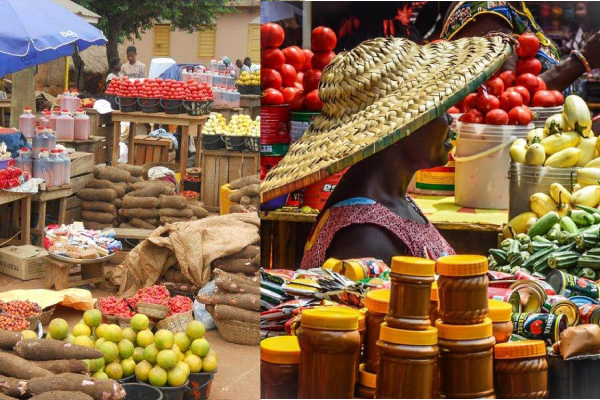According to a Financial Derivatives Company Limited (FDC) presentation at the Lagos Business School Meeting, food inflation, which is currently at a record high of 23.3 percent, is predicted to reach 26.3 percent by December.
Food inflation normally falls during the harvest season (April-July and September-December).
This year food inflation defied the trend this year due to the combined effect of flooding and structural limits.
The affected commodities, according to the FDC report, are important to the Nigerian economy. Flooding in Adamawa state has affected cotton, groundnuts, millet, cassava, guinea corn, and yams. In Benue (the nation’s food basket), commodities affected are yam, rice, beans, cassava, sweet potato, maize, soybean, sorghum, millet, sesame, and cocoyam.
[wonderplugin_video iframe=”https://youtu.be/MeeQBwabzWA” lightbox=0 lightboxsize=1 lightboxwidth=960 lightboxheight=540 autoopen=0 autoopendelay=0 autoclose=0 lightboxtitle=”” lightboxgroup=”” lightboxshownavigation=0 showimage=”” lightboxoptions=”” videowidth=600 videoheight=400 keepaspectratio=1 autoplay=0 loop=0 videocss=”position:relative;display:block;background-color:#000;overflow:hidden;max-width:100%;margin:0 auto;” playbutton=”https://www.tvcnews.tv/wp-content/plugins/wonderplugin-video-embed/engine/playvideo-64-64-0.png”]
In Cross River state, yams, cassava rice, maize, fishing, palm oil, kernels, timber, cocoa, and rubber have been affected. In Gombe, groundnuts, cotton, sorghum, millet, cowpeas, cassava, beans, onions, tobacco, etc.
Of the affected commodities, Nigeria is the largest producer of rice in Africa and the 14th highest in the world. Nigeria is the world’s largest producer of cassava and yam tubers.
Cocoa is one of Nigeria’s leading non-oil export commodities, and Nigeria is the 4th largest producing country in the world, 5th largest producer of vegetables (16.4mn tonnes), 11th largest producer of maize, 3rd largest producer of groundnuts, 3rd largest producer of sweet potato, 2nd largest producer of sorghum, and the 12th largest producer of cotton.
The price of rice, the most consumed staple, is surging as the days go by, especially towards the festive period. According to FDC findings, the price of a bag of rice (50kg) has seen a 40.86 percent surge from N34,076 before the flood to N48,000 as of today.
“The demand for rice is crazy right now because people want to buy ahead of the yuletide season as they believe that the price will go up. Since demand is high, the price will definitely keep going up. Ideally, even though there’s an increase in price, it should stabilise for a while, but because the demand is high, the sellers/importers too are taking advantage,” a middle-aged rice dealer told BusinessDay in a market survey.
A bag of maize (used for animal feeds) which used to sell for N15,000 before the flood rose to N29,000, a 93.33 percent surge.
“This rise in food inflation was caused by increases in prices of bread and cereals, food products, potatoes, yam, and other tubers, oil, and fat,” the September Consumer Price Index report by the National Bureau of Statistics (NBS) said.
The NBS monitors 43 food items in total on a state-by-state basis and tracks their prices to evaluate food inflation. Items that constitute the food basket, based on classifications, according to the six geo-political zones in the country, are brown beans, boneless beef, 500g sliced bread, white garri, onion bulb, 1 bottle of palm oil, local rice, tomato, wheat flour: Golden Penny (2kg), and yam tuber.
Should the food inflation rate increase further in the coming months, many more Nigerians will fall into poverty, according to experts.
According to a Financial Derivatives Company Limited (FDC) presentation at the Lagos Business School Meeting, food inflation, which is currently at a record high of 23.3 percent, is predicted to reach 26.3 percent by December.
Food inflation normally falls during the harvest season (April-July and September-December).
This year food inflation defied the trend this year due to the combined effect of flooding and structural limits.
The affected commodities, according to the FDC report, are important to the Nigerian economy. Flooding in Adamawa state has affected cotton, groundnuts, millet, cassava, guinea corn, and yams. In Benue (the nation’s food basket), commodities affected are yam, rice, beans, cassava, sweet potato, maize, soybean, sorghum, millet, sesame, and cocoyam.
[wonderplugin_video iframe=”https://youtu.be/MeeQBwabzWA” lightbox=0 lightboxsize=1 lightboxwidth=960 lightboxheight=540 autoopen=0 autoopendelay=0 autoclose=0 lightboxtitle=”” lightboxgroup=”” lightboxshownavigation=0 showimage=”” lightboxoptions=”” videowidth=600 videoheight=400 keepaspectratio=1 autoplay=0 loop=0 videocss=”position:relative;display:block;background-color:#000;overflow:hidden;max-width:100%;margin:0 auto;” playbutton=”https://www.tvcnews.tv/wp-content/plugins/wonderplugin-video-embed/engine/playvideo-64-64-0.png”]
In Cross River state, yams, cassava rice, maize, fishing, palm oil, kernels, timber, cocoa, and rubber have been affected. In Gombe, groundnuts, cotton, sorghum, millet, cowpeas, cassava, beans, onions, tobacco, etc.
Of the affected commodities, Nigeria is the largest producer of rice in Africa and the 14th highest in the world. Nigeria is the world’s largest producer of cassava and yam tubers.
Cocoa is one of Nigeria’s leading non-oil export commodities, and Nigeria is the 4th largest producing country in the world, 5th largest producer of vegetables (16.4mn tonnes), 11th largest producer of maize, 3rd largest producer of groundnuts, 3rd largest producer of sweet potato, 2nd largest producer of sorghum, and the 12th largest producer of cotton.
The price of rice, the most consumed staple, is surging as the days go by, especially towards the festive period. According to FDC findings, the price of a bag of rice (50kg) has seen a 40.86 percent surge from N34,076 before the flood to N48,000 as of today.
“The demand for rice is crazy right now because people want to buy ahead of the yuletide season as they believe that the price will go up. Since demand is high, the price will definitely keep going up. Ideally, even though there’s an increase in price, it should stabilise for a while, but because the demand is high, the sellers/importers too are taking advantage,” a middle-aged rice dealer told BusinessDay in a market survey.
A bag of maize (used for animal feeds) which used to sell for N15,000 before the flood rose to N29,000, a 93.33 percent surge.
“This rise in food inflation was caused by increases in prices of bread and cereals, food products, potatoes, yam, and other tubers, oil, and fat,” the September Consumer Price Index report by the National Bureau of Statistics (NBS) said.
The NBS monitors 43 food items in total on a state-by-state basis and tracks their prices to evaluate food inflation. Items that constitute the food basket, based on classifications, according to the six geo-political zones in the country, are brown beans, boneless beef, 500g sliced bread, white garri, onion bulb, 1 bottle of palm oil, local rice, tomato, wheat flour: Golden Penny (2kg), and yam tuber.
Should the food inflation rate increase further in the coming months, many more Nigerians will fall into poverty, according to experts.
According to a Financial Derivatives Company Limited (FDC) presentation at the Lagos Business School Meeting, food inflation, which is currently at a record high of 23.3 percent, is predicted to reach 26.3 percent by December.
Food inflation normally falls during the harvest season (April-July and September-December).
This year food inflation defied the trend this year due to the combined effect of flooding and structural limits.
The affected commodities, according to the FDC report, are important to the Nigerian economy. Flooding in Adamawa state has affected cotton, groundnuts, millet, cassava, guinea corn, and yams. In Benue (the nation’s food basket), commodities affected are yam, rice, beans, cassava, sweet potato, maize, soybean, sorghum, millet, sesame, and cocoyam.
[wonderplugin_video iframe=”https://youtu.be/MeeQBwabzWA” lightbox=0 lightboxsize=1 lightboxwidth=960 lightboxheight=540 autoopen=0 autoopendelay=0 autoclose=0 lightboxtitle=”” lightboxgroup=”” lightboxshownavigation=0 showimage=”” lightboxoptions=”” videowidth=600 videoheight=400 keepaspectratio=1 autoplay=0 loop=0 videocss=”position:relative;display:block;background-color:#000;overflow:hidden;max-width:100%;margin:0 auto;” playbutton=”https://www.tvcnews.tv/wp-content/plugins/wonderplugin-video-embed/engine/playvideo-64-64-0.png”]
In Cross River state, yams, cassava rice, maize, fishing, palm oil, kernels, timber, cocoa, and rubber have been affected. In Gombe, groundnuts, cotton, sorghum, millet, cowpeas, cassava, beans, onions, tobacco, etc.
Of the affected commodities, Nigeria is the largest producer of rice in Africa and the 14th highest in the world. Nigeria is the world’s largest producer of cassava and yam tubers.
Cocoa is one of Nigeria’s leading non-oil export commodities, and Nigeria is the 4th largest producing country in the world, 5th largest producer of vegetables (16.4mn tonnes), 11th largest producer of maize, 3rd largest producer of groundnuts, 3rd largest producer of sweet potato, 2nd largest producer of sorghum, and the 12th largest producer of cotton.
The price of rice, the most consumed staple, is surging as the days go by, especially towards the festive period. According to FDC findings, the price of a bag of rice (50kg) has seen a 40.86 percent surge from N34,076 before the flood to N48,000 as of today.
“The demand for rice is crazy right now because people want to buy ahead of the yuletide season as they believe that the price will go up. Since demand is high, the price will definitely keep going up. Ideally, even though there’s an increase in price, it should stabilise for a while, but because the demand is high, the sellers/importers too are taking advantage,” a middle-aged rice dealer told BusinessDay in a market survey.
A bag of maize (used for animal feeds) which used to sell for N15,000 before the flood rose to N29,000, a 93.33 percent surge.
“This rise in food inflation was caused by increases in prices of bread and cereals, food products, potatoes, yam, and other tubers, oil, and fat,” the September Consumer Price Index report by the National Bureau of Statistics (NBS) said.
The NBS monitors 43 food items in total on a state-by-state basis and tracks their prices to evaluate food inflation. Items that constitute the food basket, based on classifications, according to the six geo-political zones in the country, are brown beans, boneless beef, 500g sliced bread, white garri, onion bulb, 1 bottle of palm oil, local rice, tomato, wheat flour: Golden Penny (2kg), and yam tuber.
Should the food inflation rate increase further in the coming months, many more Nigerians will fall into poverty, according to experts.
According to a Financial Derivatives Company Limited (FDC) presentation at the Lagos Business School Meeting, food inflation, which is currently at a record high of 23.3 percent, is predicted to reach 26.3 percent by December.
Food inflation normally falls during the harvest season (April-July and September-December).
This year food inflation defied the trend this year due to the combined effect of flooding and structural limits.
The affected commodities, according to the FDC report, are important to the Nigerian economy. Flooding in Adamawa state has affected cotton, groundnuts, millet, cassava, guinea corn, and yams. In Benue (the nation’s food basket), commodities affected are yam, rice, beans, cassava, sweet potato, maize, soybean, sorghum, millet, sesame, and cocoyam.
[wonderplugin_video iframe=”https://youtu.be/MeeQBwabzWA” lightbox=0 lightboxsize=1 lightboxwidth=960 lightboxheight=540 autoopen=0 autoopendelay=0 autoclose=0 lightboxtitle=”” lightboxgroup=”” lightboxshownavigation=0 showimage=”” lightboxoptions=”” videowidth=600 videoheight=400 keepaspectratio=1 autoplay=0 loop=0 videocss=”position:relative;display:block;background-color:#000;overflow:hidden;max-width:100%;margin:0 auto;” playbutton=”https://www.tvcnews.tv/wp-content/plugins/wonderplugin-video-embed/engine/playvideo-64-64-0.png”]
In Cross River state, yams, cassava rice, maize, fishing, palm oil, kernels, timber, cocoa, and rubber have been affected. In Gombe, groundnuts, cotton, sorghum, millet, cowpeas, cassava, beans, onions, tobacco, etc.
Of the affected commodities, Nigeria is the largest producer of rice in Africa and the 14th highest in the world. Nigeria is the world’s largest producer of cassava and yam tubers.
Cocoa is one of Nigeria’s leading non-oil export commodities, and Nigeria is the 4th largest producing country in the world, 5th largest producer of vegetables (16.4mn tonnes), 11th largest producer of maize, 3rd largest producer of groundnuts, 3rd largest producer of sweet potato, 2nd largest producer of sorghum, and the 12th largest producer of cotton.
The price of rice, the most consumed staple, is surging as the days go by, especially towards the festive period. According to FDC findings, the price of a bag of rice (50kg) has seen a 40.86 percent surge from N34,076 before the flood to N48,000 as of today.
“The demand for rice is crazy right now because people want to buy ahead of the yuletide season as they believe that the price will go up. Since demand is high, the price will definitely keep going up. Ideally, even though there’s an increase in price, it should stabilise for a while, but because the demand is high, the sellers/importers too are taking advantage,” a middle-aged rice dealer told BusinessDay in a market survey.
A bag of maize (used for animal feeds) which used to sell for N15,000 before the flood rose to N29,000, a 93.33 percent surge.
“This rise in food inflation was caused by increases in prices of bread and cereals, food products, potatoes, yam, and other tubers, oil, and fat,” the September Consumer Price Index report by the National Bureau of Statistics (NBS) said.
The NBS monitors 43 food items in total on a state-by-state basis and tracks their prices to evaluate food inflation. Items that constitute the food basket, based on classifications, according to the six geo-political zones in the country, are brown beans, boneless beef, 500g sliced bread, white garri, onion bulb, 1 bottle of palm oil, local rice, tomato, wheat flour: Golden Penny (2kg), and yam tuber.
Should the food inflation rate increase further in the coming months, many more Nigerians will fall into poverty, according to experts.
According to a Financial Derivatives Company Limited (FDC) presentation at the Lagos Business School Meeting, food inflation, which is currently at a record high of 23.3 percent, is predicted to reach 26.3 percent by December.
Food inflation normally falls during the harvest season (April-July and September-December).
This year food inflation defied the trend this year due to the combined effect of flooding and structural limits.
The affected commodities, according to the FDC report, are important to the Nigerian economy. Flooding in Adamawa state has affected cotton, groundnuts, millet, cassava, guinea corn, and yams. In Benue (the nation’s food basket), commodities affected are yam, rice, beans, cassava, sweet potato, maize, soybean, sorghum, millet, sesame, and cocoyam.
[wonderplugin_video iframe=”https://youtu.be/MeeQBwabzWA” lightbox=0 lightboxsize=1 lightboxwidth=960 lightboxheight=540 autoopen=0 autoopendelay=0 autoclose=0 lightboxtitle=”” lightboxgroup=”” lightboxshownavigation=0 showimage=”” lightboxoptions=”” videowidth=600 videoheight=400 keepaspectratio=1 autoplay=0 loop=0 videocss=”position:relative;display:block;background-color:#000;overflow:hidden;max-width:100%;margin:0 auto;” playbutton=”https://www.tvcnews.tv/wp-content/plugins/wonderplugin-video-embed/engine/playvideo-64-64-0.png”]
In Cross River state, yams, cassava rice, maize, fishing, palm oil, kernels, timber, cocoa, and rubber have been affected. In Gombe, groundnuts, cotton, sorghum, millet, cowpeas, cassava, beans, onions, tobacco, etc.
Of the affected commodities, Nigeria is the largest producer of rice in Africa and the 14th highest in the world. Nigeria is the world’s largest producer of cassava and yam tubers.
Cocoa is one of Nigeria’s leading non-oil export commodities, and Nigeria is the 4th largest producing country in the world, 5th largest producer of vegetables (16.4mn tonnes), 11th largest producer of maize, 3rd largest producer of groundnuts, 3rd largest producer of sweet potato, 2nd largest producer of sorghum, and the 12th largest producer of cotton.
The price of rice, the most consumed staple, is surging as the days go by, especially towards the festive period. According to FDC findings, the price of a bag of rice (50kg) has seen a 40.86 percent surge from N34,076 before the flood to N48,000 as of today.
“The demand for rice is crazy right now because people want to buy ahead of the yuletide season as they believe that the price will go up. Since demand is high, the price will definitely keep going up. Ideally, even though there’s an increase in price, it should stabilise for a while, but because the demand is high, the sellers/importers too are taking advantage,” a middle-aged rice dealer told BusinessDay in a market survey.
A bag of maize (used for animal feeds) which used to sell for N15,000 before the flood rose to N29,000, a 93.33 percent surge.
“This rise in food inflation was caused by increases in prices of bread and cereals, food products, potatoes, yam, and other tubers, oil, and fat,” the September Consumer Price Index report by the National Bureau of Statistics (NBS) said.
The NBS monitors 43 food items in total on a state-by-state basis and tracks their prices to evaluate food inflation. Items that constitute the food basket, based on classifications, according to the six geo-political zones in the country, are brown beans, boneless beef, 500g sliced bread, white garri, onion bulb, 1 bottle of palm oil, local rice, tomato, wheat flour: Golden Penny (2kg), and yam tuber.
Should the food inflation rate increase further in the coming months, many more Nigerians will fall into poverty, according to experts.
According to a Financial Derivatives Company Limited (FDC) presentation at the Lagos Business School Meeting, food inflation, which is currently at a record high of 23.3 percent, is predicted to reach 26.3 percent by December.
Food inflation normally falls during the harvest season (April-July and September-December).
This year food inflation defied the trend this year due to the combined effect of flooding and structural limits.
The affected commodities, according to the FDC report, are important to the Nigerian economy. Flooding in Adamawa state has affected cotton, groundnuts, millet, cassava, guinea corn, and yams. In Benue (the nation’s food basket), commodities affected are yam, rice, beans, cassava, sweet potato, maize, soybean, sorghum, millet, sesame, and cocoyam.
[wonderplugin_video iframe=”https://youtu.be/MeeQBwabzWA” lightbox=0 lightboxsize=1 lightboxwidth=960 lightboxheight=540 autoopen=0 autoopendelay=0 autoclose=0 lightboxtitle=”” lightboxgroup=”” lightboxshownavigation=0 showimage=”” lightboxoptions=”” videowidth=600 videoheight=400 keepaspectratio=1 autoplay=0 loop=0 videocss=”position:relative;display:block;background-color:#000;overflow:hidden;max-width:100%;margin:0 auto;” playbutton=”https://www.tvcnews.tv/wp-content/plugins/wonderplugin-video-embed/engine/playvideo-64-64-0.png”]
In Cross River state, yams, cassava rice, maize, fishing, palm oil, kernels, timber, cocoa, and rubber have been affected. In Gombe, groundnuts, cotton, sorghum, millet, cowpeas, cassava, beans, onions, tobacco, etc.
Of the affected commodities, Nigeria is the largest producer of rice in Africa and the 14th highest in the world. Nigeria is the world’s largest producer of cassava and yam tubers.
Cocoa is one of Nigeria’s leading non-oil export commodities, and Nigeria is the 4th largest producing country in the world, 5th largest producer of vegetables (16.4mn tonnes), 11th largest producer of maize, 3rd largest producer of groundnuts, 3rd largest producer of sweet potato, 2nd largest producer of sorghum, and the 12th largest producer of cotton.
The price of rice, the most consumed staple, is surging as the days go by, especially towards the festive period. According to FDC findings, the price of a bag of rice (50kg) has seen a 40.86 percent surge from N34,076 before the flood to N48,000 as of today.
“The demand for rice is crazy right now because people want to buy ahead of the yuletide season as they believe that the price will go up. Since demand is high, the price will definitely keep going up. Ideally, even though there’s an increase in price, it should stabilise for a while, but because the demand is high, the sellers/importers too are taking advantage,” a middle-aged rice dealer told BusinessDay in a market survey.
A bag of maize (used for animal feeds) which used to sell for N15,000 before the flood rose to N29,000, a 93.33 percent surge.
“This rise in food inflation was caused by increases in prices of bread and cereals, food products, potatoes, yam, and other tubers, oil, and fat,” the September Consumer Price Index report by the National Bureau of Statistics (NBS) said.
The NBS monitors 43 food items in total on a state-by-state basis and tracks their prices to evaluate food inflation. Items that constitute the food basket, based on classifications, according to the six geo-political zones in the country, are brown beans, boneless beef, 500g sliced bread, white garri, onion bulb, 1 bottle of palm oil, local rice, tomato, wheat flour: Golden Penny (2kg), and yam tuber.
Should the food inflation rate increase further in the coming months, many more Nigerians will fall into poverty, according to experts.
According to a Financial Derivatives Company Limited (FDC) presentation at the Lagos Business School Meeting, food inflation, which is currently at a record high of 23.3 percent, is predicted to reach 26.3 percent by December.
Food inflation normally falls during the harvest season (April-July and September-December).
This year food inflation defied the trend this year due to the combined effect of flooding and structural limits.
The affected commodities, according to the FDC report, are important to the Nigerian economy. Flooding in Adamawa state has affected cotton, groundnuts, millet, cassava, guinea corn, and yams. In Benue (the nation’s food basket), commodities affected are yam, rice, beans, cassava, sweet potato, maize, soybean, sorghum, millet, sesame, and cocoyam.
[wonderplugin_video iframe=”https://youtu.be/MeeQBwabzWA” lightbox=0 lightboxsize=1 lightboxwidth=960 lightboxheight=540 autoopen=0 autoopendelay=0 autoclose=0 lightboxtitle=”” lightboxgroup=”” lightboxshownavigation=0 showimage=”” lightboxoptions=”” videowidth=600 videoheight=400 keepaspectratio=1 autoplay=0 loop=0 videocss=”position:relative;display:block;background-color:#000;overflow:hidden;max-width:100%;margin:0 auto;” playbutton=”https://www.tvcnews.tv/wp-content/plugins/wonderplugin-video-embed/engine/playvideo-64-64-0.png”]
In Cross River state, yams, cassava rice, maize, fishing, palm oil, kernels, timber, cocoa, and rubber have been affected. In Gombe, groundnuts, cotton, sorghum, millet, cowpeas, cassava, beans, onions, tobacco, etc.
Of the affected commodities, Nigeria is the largest producer of rice in Africa and the 14th highest in the world. Nigeria is the world’s largest producer of cassava and yam tubers.
Cocoa is one of Nigeria’s leading non-oil export commodities, and Nigeria is the 4th largest producing country in the world, 5th largest producer of vegetables (16.4mn tonnes), 11th largest producer of maize, 3rd largest producer of groundnuts, 3rd largest producer of sweet potato, 2nd largest producer of sorghum, and the 12th largest producer of cotton.
The price of rice, the most consumed staple, is surging as the days go by, especially towards the festive period. According to FDC findings, the price of a bag of rice (50kg) has seen a 40.86 percent surge from N34,076 before the flood to N48,000 as of today.
“The demand for rice is crazy right now because people want to buy ahead of the yuletide season as they believe that the price will go up. Since demand is high, the price will definitely keep going up. Ideally, even though there’s an increase in price, it should stabilise for a while, but because the demand is high, the sellers/importers too are taking advantage,” a middle-aged rice dealer told BusinessDay in a market survey.
A bag of maize (used for animal feeds) which used to sell for N15,000 before the flood rose to N29,000, a 93.33 percent surge.
“This rise in food inflation was caused by increases in prices of bread and cereals, food products, potatoes, yam, and other tubers, oil, and fat,” the September Consumer Price Index report by the National Bureau of Statistics (NBS) said.
The NBS monitors 43 food items in total on a state-by-state basis and tracks their prices to evaluate food inflation. Items that constitute the food basket, based on classifications, according to the six geo-political zones in the country, are brown beans, boneless beef, 500g sliced bread, white garri, onion bulb, 1 bottle of palm oil, local rice, tomato, wheat flour: Golden Penny (2kg), and yam tuber.
Should the food inflation rate increase further in the coming months, many more Nigerians will fall into poverty, according to experts.
According to a Financial Derivatives Company Limited (FDC) presentation at the Lagos Business School Meeting, food inflation, which is currently at a record high of 23.3 percent, is predicted to reach 26.3 percent by December.
Food inflation normally falls during the harvest season (April-July and September-December).
This year food inflation defied the trend this year due to the combined effect of flooding and structural limits.
The affected commodities, according to the FDC report, are important to the Nigerian economy. Flooding in Adamawa state has affected cotton, groundnuts, millet, cassava, guinea corn, and yams. In Benue (the nation’s food basket), commodities affected are yam, rice, beans, cassava, sweet potato, maize, soybean, sorghum, millet, sesame, and cocoyam.
[wonderplugin_video iframe=”https://youtu.be/MeeQBwabzWA” lightbox=0 lightboxsize=1 lightboxwidth=960 lightboxheight=540 autoopen=0 autoopendelay=0 autoclose=0 lightboxtitle=”” lightboxgroup=”” lightboxshownavigation=0 showimage=”” lightboxoptions=”” videowidth=600 videoheight=400 keepaspectratio=1 autoplay=0 loop=0 videocss=”position:relative;display:block;background-color:#000;overflow:hidden;max-width:100%;margin:0 auto;” playbutton=”https://www.tvcnews.tv/wp-content/plugins/wonderplugin-video-embed/engine/playvideo-64-64-0.png”]
In Cross River state, yams, cassava rice, maize, fishing, palm oil, kernels, timber, cocoa, and rubber have been affected. In Gombe, groundnuts, cotton, sorghum, millet, cowpeas, cassava, beans, onions, tobacco, etc.
Of the affected commodities, Nigeria is the largest producer of rice in Africa and the 14th highest in the world. Nigeria is the world’s largest producer of cassava and yam tubers.
Cocoa is one of Nigeria’s leading non-oil export commodities, and Nigeria is the 4th largest producing country in the world, 5th largest producer of vegetables (16.4mn tonnes), 11th largest producer of maize, 3rd largest producer of groundnuts, 3rd largest producer of sweet potato, 2nd largest producer of sorghum, and the 12th largest producer of cotton.
The price of rice, the most consumed staple, is surging as the days go by, especially towards the festive period. According to FDC findings, the price of a bag of rice (50kg) has seen a 40.86 percent surge from N34,076 before the flood to N48,000 as of today.
“The demand for rice is crazy right now because people want to buy ahead of the yuletide season as they believe that the price will go up. Since demand is high, the price will definitely keep going up. Ideally, even though there’s an increase in price, it should stabilise for a while, but because the demand is high, the sellers/importers too are taking advantage,” a middle-aged rice dealer told BusinessDay in a market survey.
A bag of maize (used for animal feeds) which used to sell for N15,000 before the flood rose to N29,000, a 93.33 percent surge.
“This rise in food inflation was caused by increases in prices of bread and cereals, food products, potatoes, yam, and other tubers, oil, and fat,” the September Consumer Price Index report by the National Bureau of Statistics (NBS) said.
The NBS monitors 43 food items in total on a state-by-state basis and tracks their prices to evaluate food inflation. Items that constitute the food basket, based on classifications, according to the six geo-political zones in the country, are brown beans, boneless beef, 500g sliced bread, white garri, onion bulb, 1 bottle of palm oil, local rice, tomato, wheat flour: Golden Penny (2kg), and yam tuber.
Should the food inflation rate increase further in the coming months, many more Nigerians will fall into poverty, according to experts.














